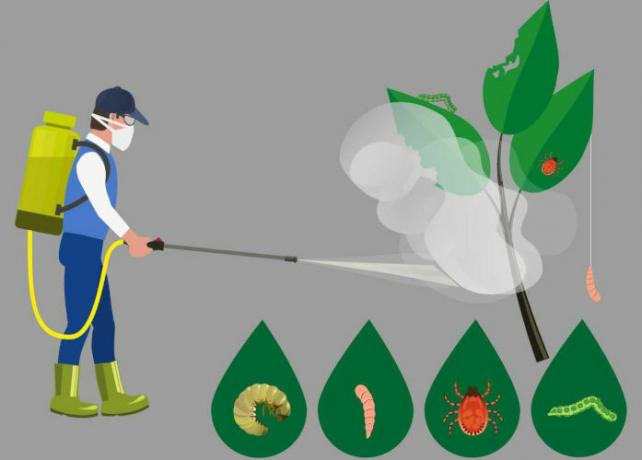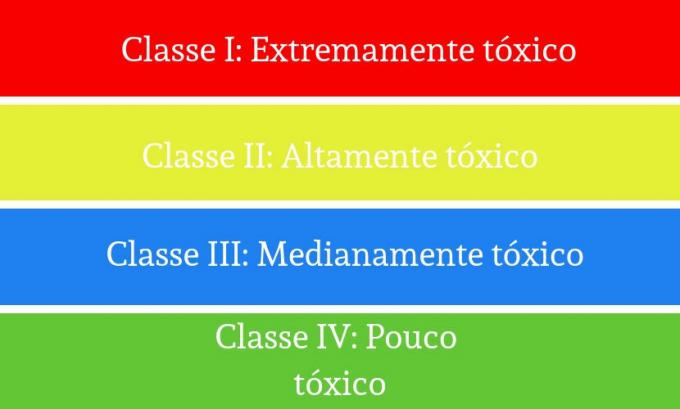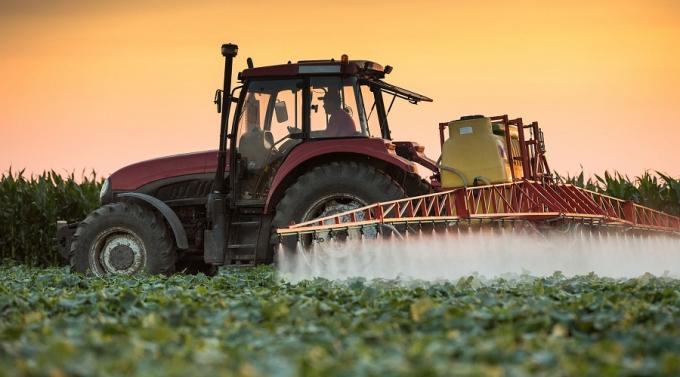Pesticides are chemical products widely used in the agricultural production sector, ensuring the crop productivity, as its use preserves the cultivated species. They are also known as pesticides or agricultural defensives. However, its use is commonly associated by several agencies, such as the World Health Organization (WHO) and the Institute Brazilian Environment and Renewable Natural Resources (IBAMA), to negative environmental impacts, as well as risks to health.
Use of pesticides

The use of pesticides is associated with combating pests and diseases that attack crops.
Pesticides are used in various environments, such as native forests, water environments and urban environments, but it is in crops and pastures that these chemicals are most used.
Read too: Intensive and extensive farming
Farmers use pesticides in order to control and combat possible pests and diseases that attack plantations, as they have the ability to act on the biological activity of living beings. This control ensures, in a way, the productivity of agricultural production, avoiding losses.
Types of pesticides
Pesticides are classified according to nature of the plague who will fight. They can also be classified according to the chemical group to which they belong and also according to the damage they cause to health and the environment. See here the classification they receive, according to the pest fought:

Types of pesticides according to the pest to be fought.
In relation to damage to human health, pesticides are classified according to their toxicity. The National Health Surveillance Agency (Anvisa) classifies them into four classes, differentiated by color and by the lethality dose for each one. In Brazil, pesticides have a toxicological classification on their labels, which indicates the potential for health risk. Check out:

Classification of pesticides by Anvisa according to toxicity.
History and use of pesticides in agriculture
The use of pesticides in agriculture it dates back to periods of classical antiquity when farmers needed to develop ways to contain pests, insects and weeds that harmed their crops. The use of these agrochemicals has intensified in agriculture about 60 years ago.
It was from the 20th century onwards — with the green revolution (introduction of new technologies that changed agricultural practices) and the promises of increased productivity and expansion of agribusiness sectors - which pesticides gained prominence.
Read too: Organic agriculture
The modernization of agriculture, associated with large estates (large tracts of land) and monocultures, caused pesticides to be intensively used in crops. Monocultures, planting a single species, favor the cycle of pests and diseases, causing need to use pesticides in order to ensure productivity, avoiding risks and damage to the plantation.

It is in agriculture that pesticides are widely used in order to ensure productivity and preserve the planted species.
According to the National Union of Vegetal Defense Products Industry (Sindiveg), in 2017, the The main agricultural productions that were champions in the use of pesticides were soy, sugar cane, corn and cotton.
Certainly, pesticides have a fundamental role in the expansion of agribusiness and, consequently, favoring the economy and also the supply of food in the world. However, the excessive or incorrect use of these chemicals can cause several damages to the environment, such as contamination of soil and water resources, animal poisoning, as well as the disappearance of insect species, according to the Ministry of Environment Environment.
also know: What is family farming?
Another problem related to the misuse of pesticides has to do with human health. Data released by the World Health Organization associate exposure to pesticides to poisoning that can cause cardiac arrhythmias, respiratory allergies, among other diseases. United Nations Representatives (UN) believe that preventing people from being exposed to pesticides, whether through food or contaminated environments, would possibly reduce cases of heart disease and stroke|1|.
Pesticides in food
Anvisa released a report on pesticide residues in food, through PARA (Pesticide Residues in Food Analysis Program). The research was carried out between 2013 and 2015, using about 12 thousand food samples, and in them it was found the presence of agrochemicals that pose a risk to health|2|.
The agency evaluated cereals, fruits, legumes, vegetables and roots. The food with more contaminated samples was orange. Among the 744 samples, 90 had the potential for an acute risk of contamination.
Other foods — such as peppers, zucchini and strawberries — are at risk considered acceptable. However, although the irregularities do not indicate a risk, from an acute point of view, to the health of the consumer, in most of the samples analyzed, it was pointed out that farmers who use pesticides outside the recommendations may expose their health.
Read too: food preservation

Tomato is a food that has a high concentration of pesticides. About 16.3% have contamination according to Anvisa.
Anvisa also released a list, in 2010, which indicates foods that have a high level of contamination by pesticides. This list took into account, for the analysis, the levels of pesticide residues above what is allowed and also the presence of pesticides that are not allowed in food. The most contaminated foods are:
- Pepper: 91.8% of contaminated samples;
- Strawberry: 63.4% of contaminated samples;
- Cucumber: 57.4% of contaminated samples;
- Lettuce: 54.2% of contaminated samples.
→ How to avoid exposure to pesticide residues in food?
Anvisa makes some recommendations, such as:
- Choose foods with labels that identify the producer;
- Choose organic food;
- Washing procedures in running water and the removal of leaves and bark contribute to reducing the existing pesticide residues.
Pesticides in Brazil
Brazil is the country that most uses pesticides in the world, since 2016, according to data released by Anvisa, and is considered one of the greatest powers in the agricultural sector. Around US$ 10 billion are traded in the country each year in the sale of agrochemical products, according to data from Revista Pesquisa Fapesp.
IBGE data also reveal that the use of pesticides in the country increased about 21.2% in 11 years (between the periods of 2006 and 2017)|3|. In Brazil, in 2017, approximately 540 thousand tons of pesticides were used, double the amount used in 2010, according to research by Ibama|4|.
→ Why, in Brazil, are so many pesticides used?
What leads to the intense use of pesticides in Brazil is linked to climatic factors, as well as the characteristics of agricultural production in the country. Brazil is a tropical country, not having, in a large part of its territory, periods of low temperature. This ends up favoring the cycle of pests and diseases, as this is not broken with the change in temperature.
Another factor is the issue of agricultural production in the country. Monoculture prevails and this practice also favors the cycle of pests and diseases that attack crops, thus requiring the use of pesticides to combat them.
→ Legislation
In Brazil, the use of pesticides is regulated by the Law of Pesticides No. 7.802, 1989, regulated by Decree No. 4.074, 2002|6|. This law contains restrictions on this use, as well as defining what, how much and by whom it can be done. In early 2019, this law was amended through a bill presented and approved by the Chamber. The project is authored by federal deputy Luiz Nishimori and provides for the release of pesticides by the Ministry of Agriculture, preventing bodies such as Ibama and Anvisa from interfering. There was, then, a relaxation of the rules for the production, sale and distribution of pesticides. That same year, the Ministry of Agriculture approved the registration of highly toxic pesticides in the country. Anvisa declared that pesticides that were banned in countries — such as China, the United States and countries of the European Union — have been used in national territory.
The flexibility of the pesticide law has been questioned by environmentalists and health and environmental agencies. These criticize the Federal Government's permissiveness and point out several problems associated with the use of pesticides. In contrast, rural producers say its use is inevitable, considering that agribusiness depends on the productivity of crops.
→ Main pesticides sold in Brazil
According to Ibama|5|, the main pesticides sold in Brazil in 2016 were:
glyphosate |
2,4-D |
Mancozeb |
atrazine |
Advantages and disadvantages of using pesticides
1. Benefits
- The correct use and in recommended dosages of pesticides guarantees the control of pests and diseases that damage the plantations;
- The control of pests and diseases guarantees the productivity of crops;
- The use of pesticides improves the visual quality of cultivated products;
- Generally, the prices of products in which pesticides were used are lower than the prices of organic products.
2. Disadvantages
- Pesticides stored in inappropriate environments can pose health risks;
- The incorrect use and in non-recommended doses of pesticides is associated, by health agencies, with several health problems;
- The incorrect use of pesticides is also associated with environmental problems, such as contamination of soil, water resources and also fauna and flora;
- Excessive doses of pesticides can contaminate food and put health at risk.
__________________
Grades:
1Pesticides and other chemicals kill 193,000 people worldwide each year, says the UN. To access, Click here.
2Report on pesticide residues in food. To access, Click here.
3Use of pesticides increases by 21% in 11 years in Brazil. To access, Click here.
4-5 Pesticides in the hot seat. To access, Click here.
6 Decree 4.074 - 2002 Pesticides. To access, Click here.


